Assessment of Climate Indices over the Carpathian Basin Based on ALADIN5.2 and REMO2015 Regional Climate Model Simulations
Abstract
1. Introduction
2. Data and Methodology
2.1. Regional Climate Model Experiments
2.2. Observational Dataset: CarpatClim-HU
2.3. Evaluation Methods
3. Results
3.1. Validation for 1981–2000
3.1.1. Temperature
3.1.2. Precipitation
3.2. Projections for 2021–2050 and 2071–2100
3.2.1. Temperature
3.2.2. Precipitation
4. Conclusions
Author Contributions
Funding
Institutional Review Board Statement
Informed Consent Statement
Data Availability Statement
Acknowledgments
Conflicts of Interest
References
- Lakatos, M.; Bihari, Z.; Izsák, B.; Marton, A.; Szentes, O. Megfigyelt éghajlati változások Magyarországon (Observed climate change in Hungary). Légkör 2021, 66, 5–11, ISSN 0133-3666. [Google Scholar]
- Szolnoki-Tótiván, B. 2022 nyarának időjárása. (The weather of 2022 summer). Légkör 2022, 67, 169–174, ISSN 0133-3666. [Google Scholar]
- Lakatos, M.; Bihari, Z.; Szentimrey, T.; Spinoni, J.; Szalai, S. Analyses of temperature extremes in the Carpathian Region in the period 1961–2010. Időjárás 2016, 120, 41–51. [Google Scholar]
- Bokros, K.; Lakatos, M. Hőségperiódusok vizsgálata Magyarországon a XX. század elejétől napjainkig (Analysis of Hot Spells in Hungary from the Early 20th Century to the Present). Légkör 2022, 67, 130–140, ISSN 0133-3666. [Google Scholar] [CrossRef]
- Lakatos, M.; Bihari, Z.; Izsák, B.; Szentes, O. Globális és hazai éghajlati trendek, szélsőségek változása: 2020-as helyzetkép. (Global Trends and Climate Change in Hungary in 2020). Sci. Et Secur. 2021, 2, 164–171, ISSN 2732-2688. [Google Scholar]
- Christensen, J.H.; Hewitson, B.; Busuioc, A.; Chen, A.; Gao, X.; Held, I.; Jones, R.; Kolli, R.K.; Kwon, W.-T.; Laprise, R.; et al. Regional Climate Projections. In Climate Change 2007: The Physical Science Basis. Contribution of Working Group I to the Fourth Assessment Report of the Intergovernmental Panel on Climate Change; Solomon, S., Qin, D., Manning, M., Chen, Z., Marquis, M., Averyt, K., Tignor, M., Miller, H., Eds.; Cambridge University Press: Cambridge, UK; New York, NY, USA, 2007. [Google Scholar]
- Vautard, R.; Gobiet, A.; Sobolowski, S.; Kjellström, E.; Stegehuis, A.; Watkiss, P.; Mendlik, T.; Landgren, O.; Nikulin, G.; Teichmann, C.; et al. The European climate under a 2 °C global warming. Environ. Res. Lett. 2014, 9, 034006. [Google Scholar] [CrossRef]
- Christensen, J.H.; Christensen, O.B. A summary of the PRUDENCE model projections of changes in European climate by the end of this century. Clim. Chang. 2007, 81 (Suppl. S1), 7–30. [Google Scholar] [CrossRef]
- Giorgi, F.; Coppola, E. The European Climate-Change Oscillation (ECO). Geophys. Res. Lett. 2007, 34, L217003. [Google Scholar] [CrossRef]
- Jacob, D.; Petersen, J.; Eggert, B.; Alias, A.; Christensen, O.B.; Bouwer, L.M.; Braun, A.; Colette, A.; Déqué, M.; Georgievski, G.; et al. EURO-CORDEX: New high-resolution climate change projections for European impact research. Reg. Environ. Chang. 2014, 14, 563–578. [Google Scholar] [CrossRef]
- Kjellström, E.; Nikulin, G.; Strandberg, G.; Christensen, O.B.; Jacob, D.; Keuler, K.; Lenderink, G.; van Meijgaard, E.; Schär, C.; Somot, S.; et al. European climate change at global mean temperature increases of 1.5 and 2 °C above pre-industrial conditions as simulated by the EURO-CORDEX regional climate models. Earth Syst. Dyn. 2018, 9, 459–478. [Google Scholar] [CrossRef]
- Coppola, E.; Nogherotto, R.; Ciarlò, J.M.; Giorgi, F.; van Meijgaard, E.; Kadygrov, N.; Iles, C.; Corre, L.; Sandstad, M.; Somot, S.; et al. Assessment of the European Climate Projections as Simulated by the Large EURO-CORDEX Regional and Global Climate Model Ensemble. J. Geophys. Res. Atmos. 2021, 126, e2019JD032356. [Google Scholar] [CrossRef]
- Rajczak, J.; Schär, C. Projections of future precipitation extremes over Europe: A multimodel assessment of climate simulations. J. Geophys. Res. Atmos. 2017, 122, 10–773. [Google Scholar] [CrossRef]
- Szabó, P.; Szépszó, G. Quantifying sources of uncertainty in temperature and precipitation projections over Central Europe. In Mathematical Problems in Meteorological Modelling; Bátkai, A., Csomós, P., Faragó, I., Horányi, A., Szépszó, G., Eds.; Springer International Publishing: Berlin/Heidelberg, Germany, 2016; pp. 207–237. [Google Scholar]
- Szabó, P. Sources of uncertainties: Added value of the evolution of climate model simulations over Central Europe? In Proceedings of the Annual Meeting of the European Meteorological Society (EMS)/European Conference for Applied Meteorology and Climatology, Budapest, Hungary, 3–7 September 2018. [Google Scholar]
- Krüzselyi, I.; Bartholy, J.; Horányi, A.; Pieczka, I.; Pongrácz, R.; Szabó, P.; Szépszó, G.; Torma, C. The future climate characteristics of the Carpathian Basin based on a regional climate model mini-ensemble. Adv. Sci. Res. 2011, 6, 69–73. [Google Scholar] [CrossRef]
- Nakicenovic, N.; Alcamo, J.; Davis, G.; de Vries, B.; Fenhann, J.; Gaffin, S.; Gregory, K.; Grübler, A.; Jung, T.Y.; Kram, T.; et al. IPCC Special Report on Emission Scenarios; Cambridge University Press: Cambridge, UK, 2000. [Google Scholar]
- Bán, B.; Szépszó, G.; Allaga-Zsebeházi, G.; Somot, S. ALADIN-Climate at the Hungarian Meteorological Service: From the beginnings to the present day’s results. Időjárás 2021, 125, 647–673. [Google Scholar] [CrossRef]
- Jacob, D.; Teichmann, C.; Sobolowski, S.; Katragkou, E.; Anders, I.; Belda, M.; Benestad, R.; Boberg, F.; Buonomo, E.; Cardoso, R.M.; et al. Regional climate downscaling over Europe: Perspectives from the EURO-CORDEX community. Reg. Environ. Chang. 2020, 20, 1–20. [Google Scholar] [CrossRef]
- Colin, J.; Déqué, M.; Radu, R.; Somot, S. Sensitivity study of heavy precipitations in Limited Area Model climate simulation: Influence of the size of the domain and the use of the spectral nudging technique. Tellus-A 2010, 62, 591–604. [Google Scholar] [CrossRef]
- Tegen, I.; Hollrig, P.; Chin, M.; Fung, I.; Jacob, D.; Penner, J. Contribution of different aerosol species to the global aerosol extinction optical thickness: Estimates from model results. J. Geophys. Res. 1997, 102, 23895–23915. [Google Scholar] [CrossRef]
- Szopa, S.; Balkanski, Y.; Schulz, M.; Bekki, S.; Cugnet, D.; Fortems-Cheiney, A.; Turquety, S.; Cozic, A.; Déandreis, C.; Hauglustaine, D.; et al. Aerosol and ozone changes as forcing for climate evolution between 1850 and 2100. Clim. Dyn. 2013, 40, 2223–2250. [Google Scholar] [CrossRef]
- Jacob, D.; Podzun, R. Sensitivity studies with the regional climate model REMO. Meteor. Atmos. Phys. 1997, 63, 119–129. [Google Scholar] [CrossRef]
- Jacob, D.; Bärring, L.; Christensen, O.B.; Christensen, J.H.; Castro, M.D.; Déqué, M.; Giorgi, F.; Hagemann, S.; Hirschi, M.; Jones, R.; et al. An inter-comparison of regional climate models for Europe: Model performance in present-day climate. Clim. Chang. 2007, 81, 31–52. [Google Scholar] [CrossRef]
- Majewski, D. The Europa Modell of the Deutscher Wetterdienst. In ECMWF Seminar of Numerical Methods in Atmospheric Models II; ECMWF: Reading, UK, 1991; pp. 147–191. [Google Scholar]
- Roeckner, E.; Arpe, K.; Bengtsson, L.; Christoph, M.; Claussen, M.; Dümenil, L.; Esch, M.; Giorgetta, M.; Schlese, U.; and Schulzweida, U. The Atmospheric General Circulation Model ECHAM-4: MODEL Description and Simulation of Present-Day Climate; Report No. 1996, 18; Max Planck Institute for Meteorology: Hamburg, Germany, 1996. [Google Scholar]
- Arakawa, A.; Lamb, V. Computational design and the basic dynamical processes of the UCLA general circulation Model. Methods Comput. Phys. 1977, 17, 173–265. [Google Scholar]
- Tanré, D.; Geleyn, J.F.; Slingo, J. First results of the introduction of an advanced aerosol-radiation interaction in the ECMWF low resolution global model. In Aerosol and Their Climatic Effects; Gerber, H.E., Deepak, A., Hampton, V., Eds.; Deepak Pub: Hampton, VA, USA, 1984; pp. 133–177. [Google Scholar]
- Suga, R.; Megyeri-Korotaj, O.A.; Allaga-Zsebeházi, G. Sensitivity study of the REMO regional climate model to domain size. Adv. Sci. Res. 2021, 18, 157–167. [Google Scholar] [CrossRef]
- Davies, H.C. A lateral boundary formulation for multi-level prediction models. Q. J. R. Meteorol. Soc. 1976, 102, 405–418. [Google Scholar]
- Fouquart, Y.; Bonnel, B. Computations of solar heating of the Earth’s atmosphere: A new parameterization. Contrib. Atmos. Phys. 1980, 53, 35–62. [Google Scholar]
- Mlawer, E.J.; Taubman, S.J.; Brown, P.D.; Iacono, M.J.; Clough, S.A. Radiative transfer for inhomogeneous atmospheres: RRTM, a validated correlated-k model for the longwave. J. Geophys. Res. 1997, 102D, 16663–16682. [Google Scholar] [CrossRef]
- Morcrette, J.-J. Description of the Radiation Scheme in the ECMWF Model; European Centre for Medium-Range Weather Forecasts: Reading, UK, 1989. [Google Scholar] [CrossRef]
- Masson, V.; Le Moigne, P.; Martin, E.; Faroux, S.; Alias, A.; Alkama, R.; Belamari, S.; Barbu, A.; Boone, A.; Bouyssel, F.; et al. The SURFEXv7.2 land and ocean surface platform for coupled or offline simulation of earth surface variables and fluxes. Geosci. Model Dev. 2013, 6, 929–960. [Google Scholar] [CrossRef]
- Noilhan, J.; Mahfouf, J.-F. The ISBA land surface parameterisation scheme. Glob. Planet. Chang. 1996, 13, 145–159, ISSN 0921-8181. [Google Scholar] [CrossRef]
- Charnock, H. Wind stress on a water surface. Q. J. R. Meteorol. Soc. 1955, 81, 639–640. [Google Scholar] [CrossRef]
- Monin, A.S.; Obukhov, A.M. Basic laws of turbulent mixing in the surface layer of the atmosphere. Contrib. Geophys. Inst. Acad. Sci. USSR 1954, 151, e187. [Google Scholar]
- Smith, R.N.B. A scheme for predicting layer clouds and their water content in a general circulation model. Q. J. R. Meteorol. Soc. 1990, 116, 435–460. [Google Scholar] [CrossRef]
- Sundqvist, H. A parameterization scheme for non-convective condensation including prediction of cloud water content. Q. J. R. Meteorol. Soc. 1978, 104, 677–690. [Google Scholar] [CrossRef]
- Ricard, J.L.; Royer, J.F. A statistical cloud scheme for use in an AGCM. Ann. Geophys. 1993, 11, 1095–1115. [Google Scholar]
- Lohmann, U.; Roeckner, E. Design and performance of a new cloud microphysics scheme developed for the ECHAM general circulation model. Clim. Dyn. 1996, 12, 557–572. [Google Scholar] [CrossRef]
- Bougeault, P. A simple parameterization of the large-scale effects of cumulus convection. Mon. Weather. Rev. 1985, 113, 2108–2121. [Google Scholar] [CrossRef]
- Tiedtke, M. A comprehensive mass flux scheme for cumulus parameterization in large-scale models. Mon. Weather. Rev. 1989, 117, 1779–1800. [Google Scholar] [CrossRef]
- Boros-Törék, O.; Krüzselyi, I.; Szépszó, G. Sensitivity study on the integration domain size with ALADIN-Climate RCM. Geophys. Res. Abstr. 2015, 17, EGU2015-6163-3. [Google Scholar]
- Dee, D.P.; Uppala, S.M.; Simmons, A.J.; Berrisford, P.; Poli, P.; Kobayashi, S.; Andrae, U.; Balmaseda, M.A.; Balsamo, G.; Bauer, P.; et al. The ERA-Interim reanalysis: Configuration and performance of the data assimilation system. Q. J. R. Meteorol. Soc. 2011, 137, 553–597. [Google Scholar] [CrossRef]
- Voldoire, A.; Sanchez-Gomez, E.; Salas y Mélia, D.; Decharme, B.; Cassou, C.; Sénési, S.; Valcke, S.; Beau, I.; Alias, A.; Chevallier, M.; et al. The CNRM-CM5.1 Global Climate Model: Description and Basic Evaluation. Clim. Dyn. 2013, 40, 2091–2121. [Google Scholar] [CrossRef]
- Giorgetta, M.A.; Jungclaus, J.; Reick, C.H.; Legutke, S.; Bader, J.; Böttinger, M.; Brovkin, V.; Crueger, T.; Esch, M.; Fieg, K.; et al. Climate and carbon cycle changes from 1850 to 2100 in MPI-ESM simulations for the Coupled Model Intercomparison Project phase 5. J. Adv. Model. Earth Syst. 2013, 5, 572–597. [Google Scholar] [CrossRef]
- Teichmann, C.; Eggert, B.; Elizalde, A.; Haensler, A.; Jacob, D.; Kumar, P.; Moseley, C.; Pfeifer, S.; Rechid, D.; Remedio, A.R.; et al. How Does a Regional Climate Model Modify the Projected Climate Change Signal of the Driving GCM: A Study over Different CORDEX Regions Using REMO. Atmosphere 2013, 4, 214–236. [Google Scholar] [CrossRef]
- Moss, R.H.; Edmonds, J.A.; Hibbard, K.A.; Manning, M.R.; Rose, S.K.; van Vuuren, D.P.; Carter, T.R.; Emori, S.; Kainuma, M.; Kram, T.; et al. The next generation of scenarios for climate change research and assessment. Nature 2010, 463, 747–756. [Google Scholar] [CrossRef] [PubMed]
- Bihari, Z.; Lakatos, M.; Szentimrey, T. Felszíni megfigyelésekből készített rácsponti adatbázisok az Országos Meteorológiai Szolgálatnál (Gridded data series prepared from surface observation at Hungarian Meteorological Service). Légkör 2017, 62, 148–151. [Google Scholar]
- Szentimrey, T. Development of MASH homogenization procedure for daily data. In Proceedings of the Fifth Seminar for Homogenization and Quality Control in Climatological Databases, Budapest, Hungary, 29 May–2 June 2006; WCDMP-No.71, WMO/TD-No. 1493. pp. 123–130. [Google Scholar]
- Szentimrey, T. Manual of homogenization software MASHv3.03. Hung. Meteorol. Serv. 2017, 71. [Google Scholar]
- Szentimrey, T.; Bihari, Z. Mathematical background of the spatial interpolation methods and the software MISH (Meteorological Interpolation based on Surface Homogenized Data Basis). In Proceedings of the Conference on Spatial Interpolation in Climatology and Meteorology, Budapest, Hungary, 11–15 January 2004; COST Action 719, COST Office. pp. 17–27. [Google Scholar]
- Szentimrey, T.; Bihari, Z. Manual of interpolation software MISHv1.03. Hung. Meteorol. Serv. 2014, 60. [Google Scholar]
- Hoffmann, L.; Izsák, B.; Lakatos, M. Comparison of different interpolation methods for Hungarian climatological data. EMS Annu. Meet. Abstr. 2018, 15, EMS2018-496. [Google Scholar]
- Taylor, K.E. Summarizing multiple aspects of model performance in a single diagram. J. Geophys. Res. Atmos. 2001, 106, 7183–7192. [Google Scholar] [CrossRef]
- Vautard, R.; Kadygrov, N.; Iles, C.; Boberg, F.; Buonomo, E.; Bülow, K.; Coppola, E.; Corre, L.; van Meijgaard, E.; Nogherotto, R.; et al. Evaluation of the large EURO-CORDEX regional climate model ensemble. J. Geophys. Res. Atmos. 2021, 126, e2019JD032344. [Google Scholar] [CrossRef]
- Rai, P.; Ziegler, K.; Abel, D.; Pollinger, F.; Paeth, H. Performance of a regional climate model with interactive vegetation (REMO-iMOVE) over Central Asia. Theor. Appl. Climatol. 2022, 150, 1385–1405. [Google Scholar] [CrossRef]
- Lucas-Picher, P.; Argüeso, D.; Brisson, E.; Tramblay, Y.; Berg, P.; Lemonsu, A.; Kotlarski, S.; Caillaud, C. Convection-permitting modeling with regional climate models: Latest developments and next steps. Wiley Interdiscip. Rev. Clim. Chang. 2021, 12, e731. [Google Scholar] [CrossRef]
- Berthou, S.; Kendon, E.J.; Chan, S.C.; Ban, N.; Leutwyler, D.; Schär, C.; Fosser, G. Pan-European climate at convection-permitting scale: A model intercomparison study. Clim. Dyn. 2020, 55, 35–59. [Google Scholar] [CrossRef]
- Boé, J.; Somot, S.; Corre, L.; Nabat, P. Large discrepancies in summer climate change over Europe as projected by global and regional climate models: Causes and consequences. Clim. Dyn. 2020, 54, 2981–3002. [Google Scholar] [CrossRef]
- Kendon, E.J.; Roberts, N.M.; Senior, C.A.; Roberts, M.J. Realism of rainfall in a very high-resolution regional climate model. J. Clim. 2012, 25, 5791–5806. [Google Scholar] [CrossRef]
- Kendon, E.J.; Ban, N.; Roberts, N.M.; Fowler, H.J.; Roberts, M.J.; Chan, S.C.; Evans, J.P.; Fosser, G.; Wilkinson, J.M. Do Convection-Permitting Regional Climate Models Improve Projections of Future Precipitation Change? Bull. Am. Meteorol. Soc. 2017, 98, 79–93, Retrieved 10 January 2023. [Google Scholar] [CrossRef]
- Prein, A.F.; Gobiet, A.; Suklitsch, M.; Truhetz, H.; Awan, N.K.; Keuler, K.; Georgievski, G. Added value of convection permitting seasonal simulations. Clim. Dyn. 2013, 41, 2655–2677. [Google Scholar] [CrossRef]
- Ban, N.; Schmidli, J.; Schär, C. Evaluation of the convection resolving regional climate modeling approach in decade-long simulations. J. Geophys. Res. Atmos. 2014, 119, 7889–7907. [Google Scholar] [CrossRef]


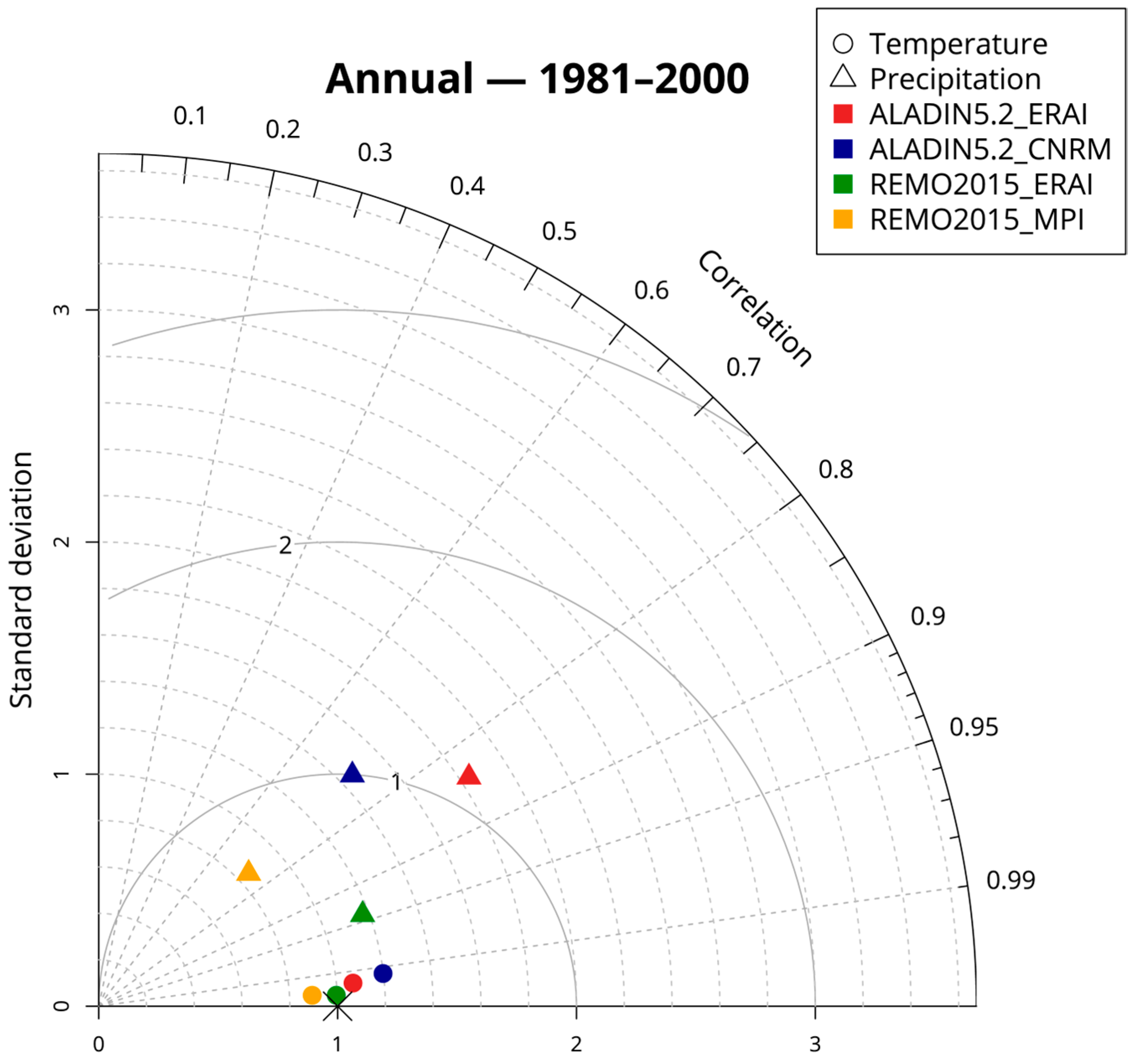




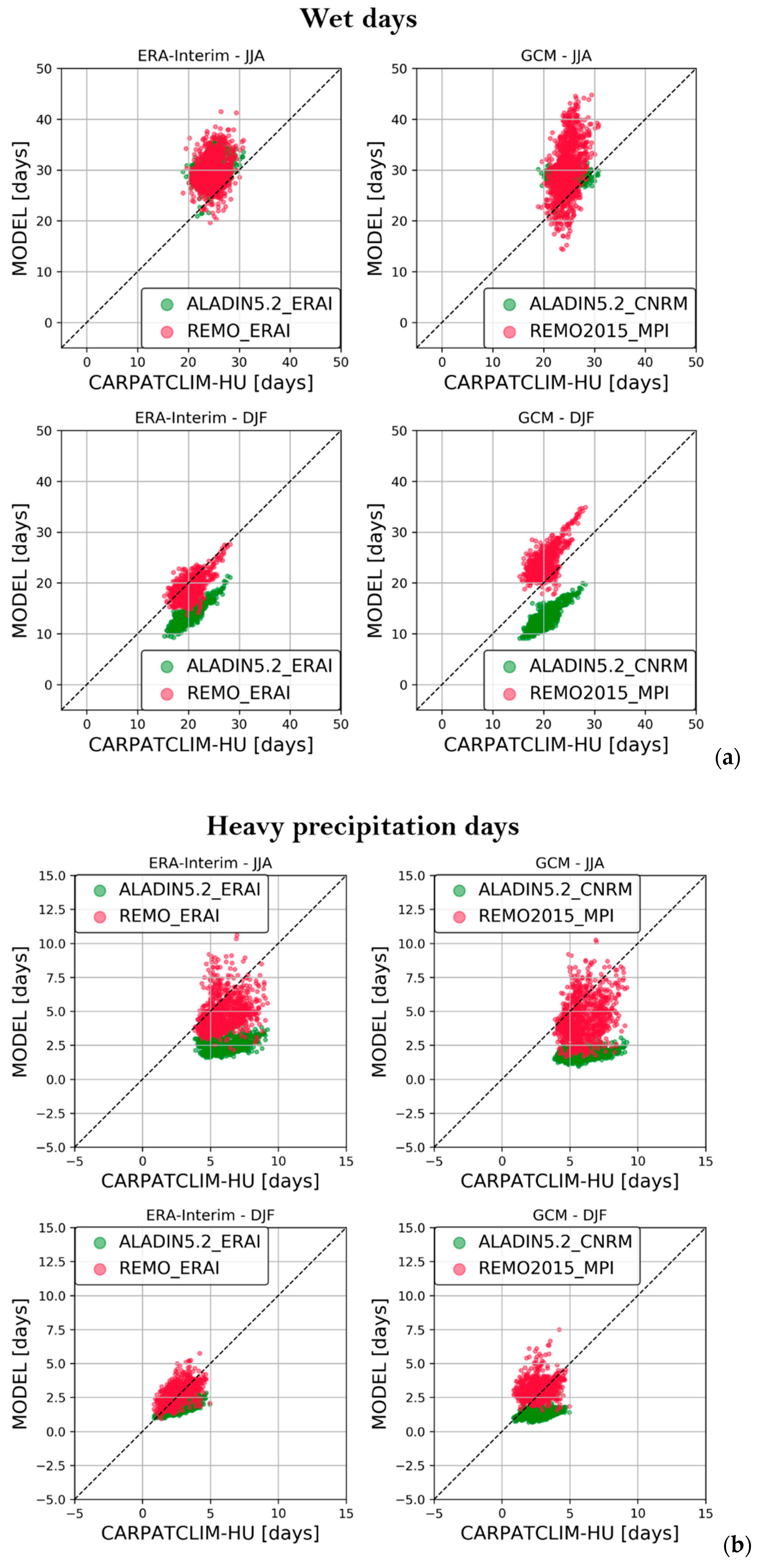
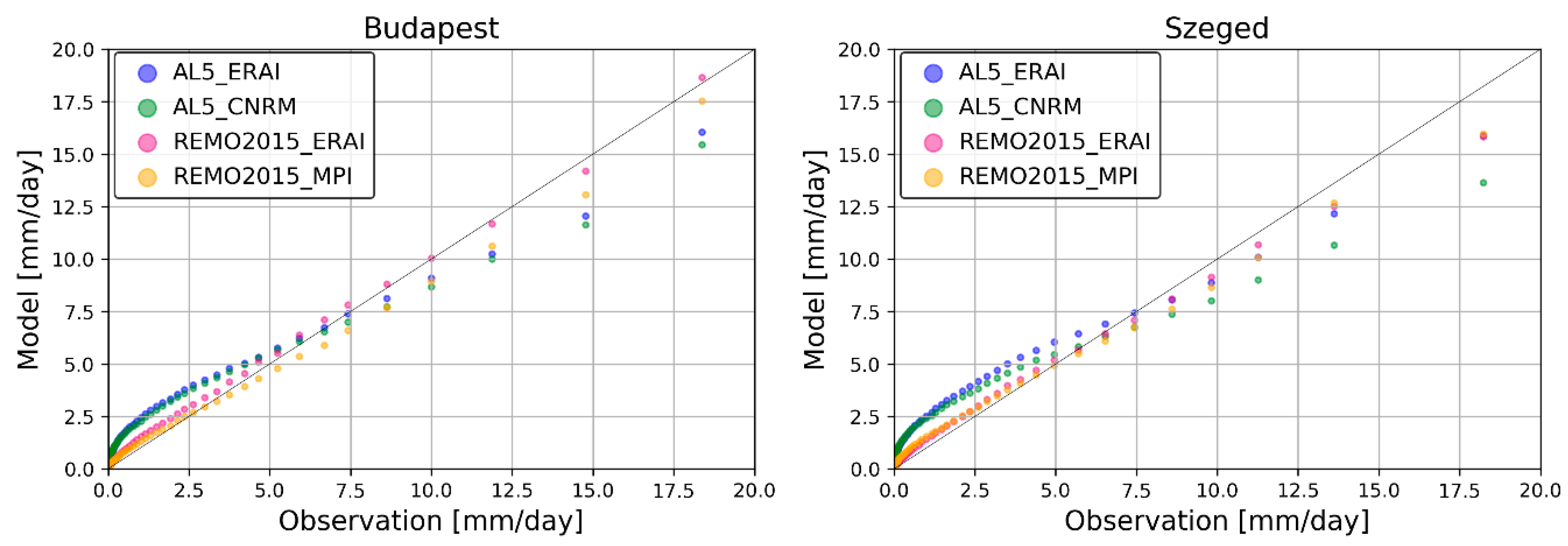

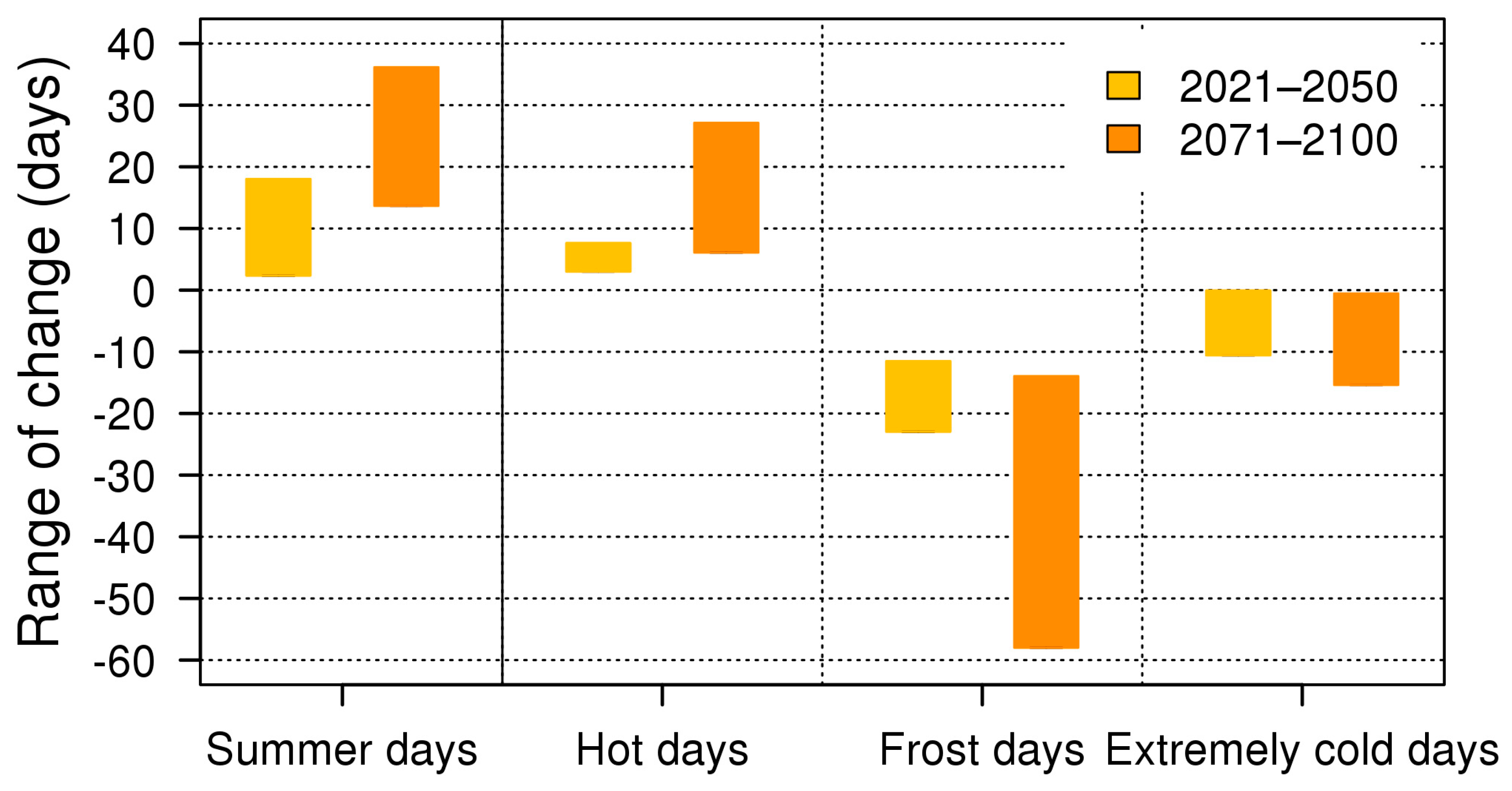
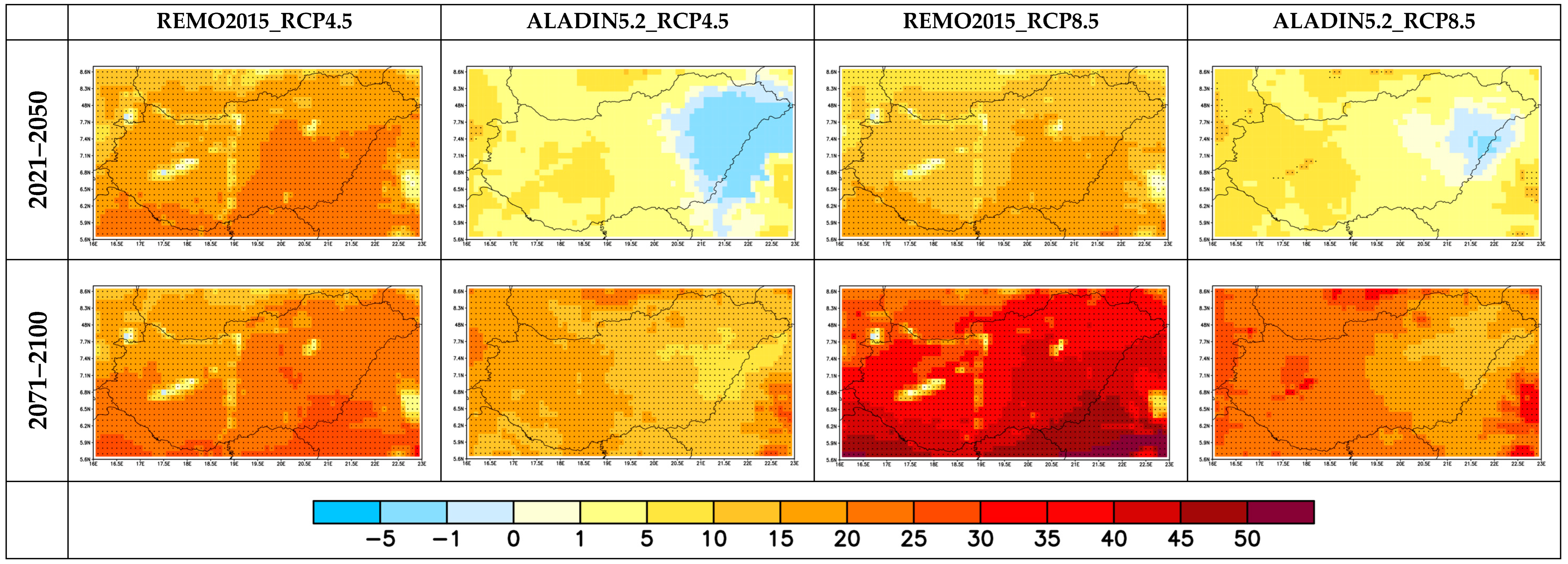



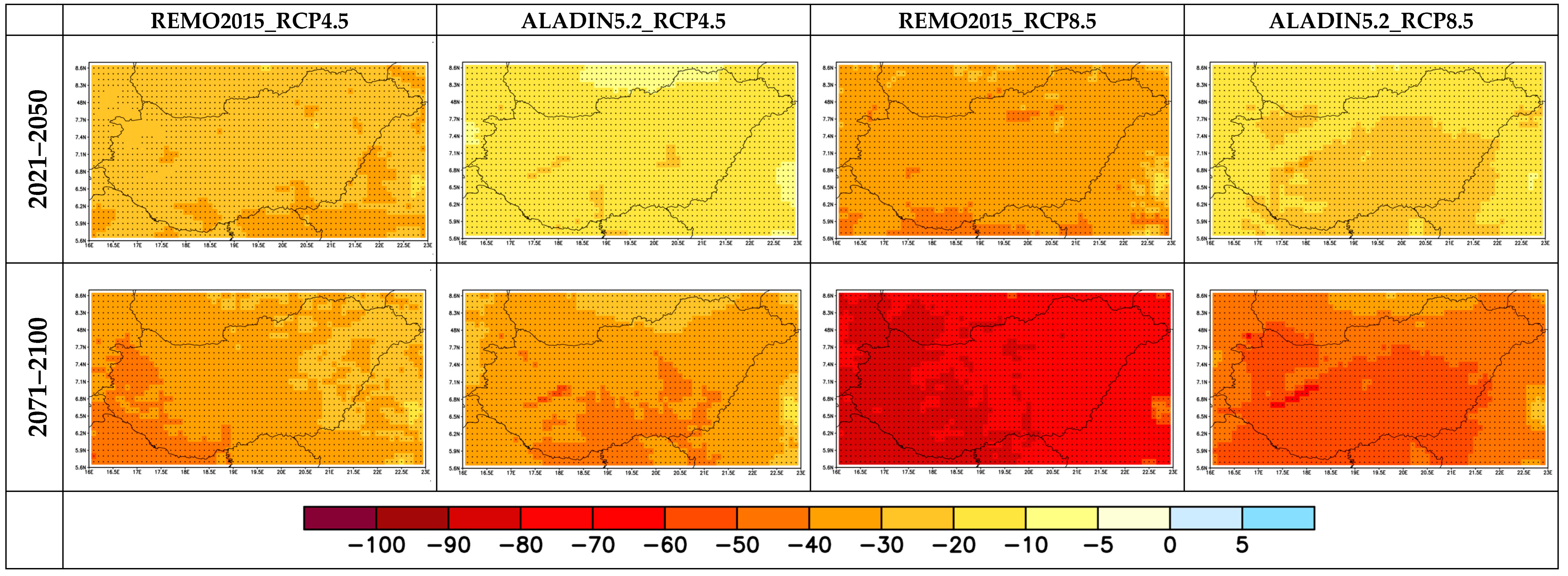


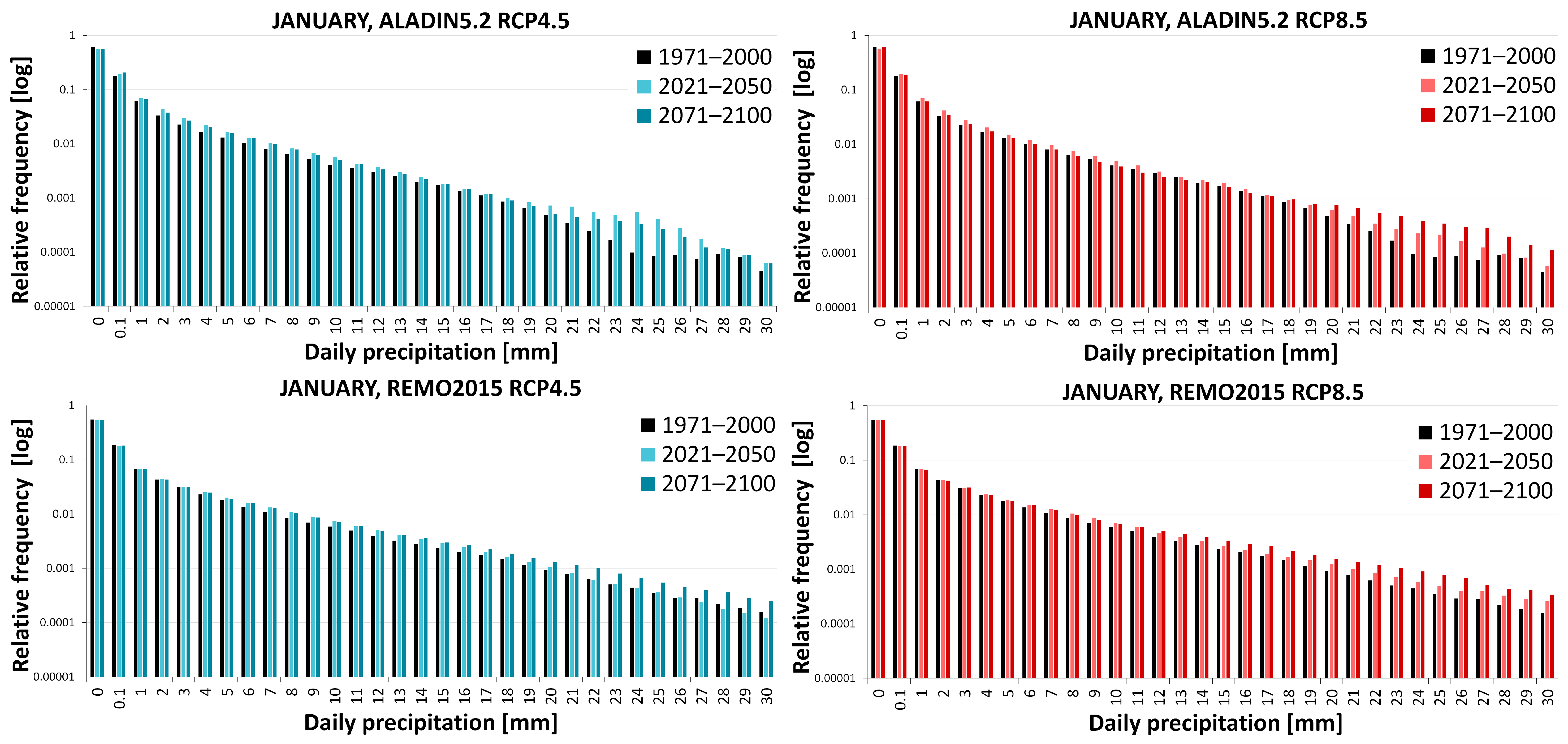
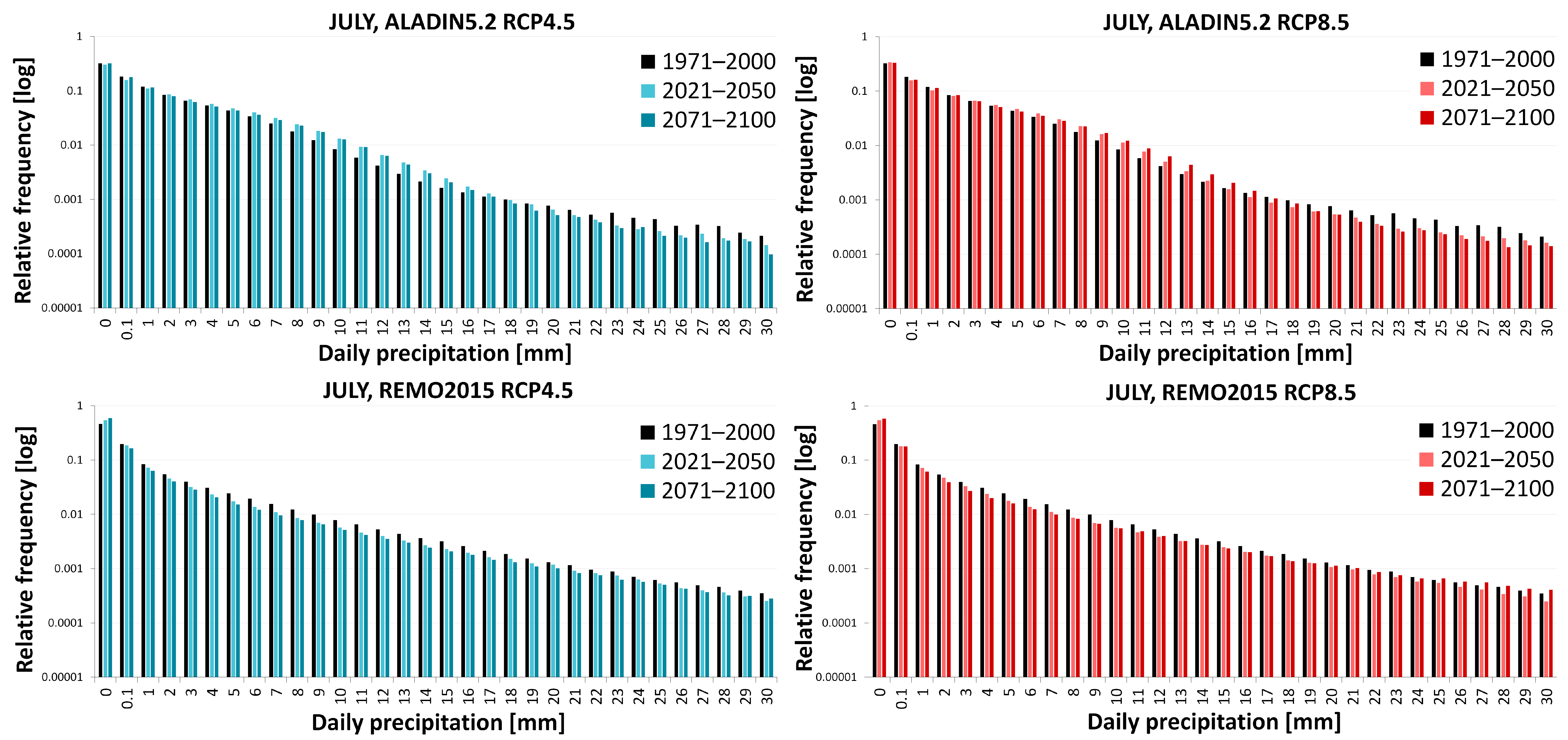


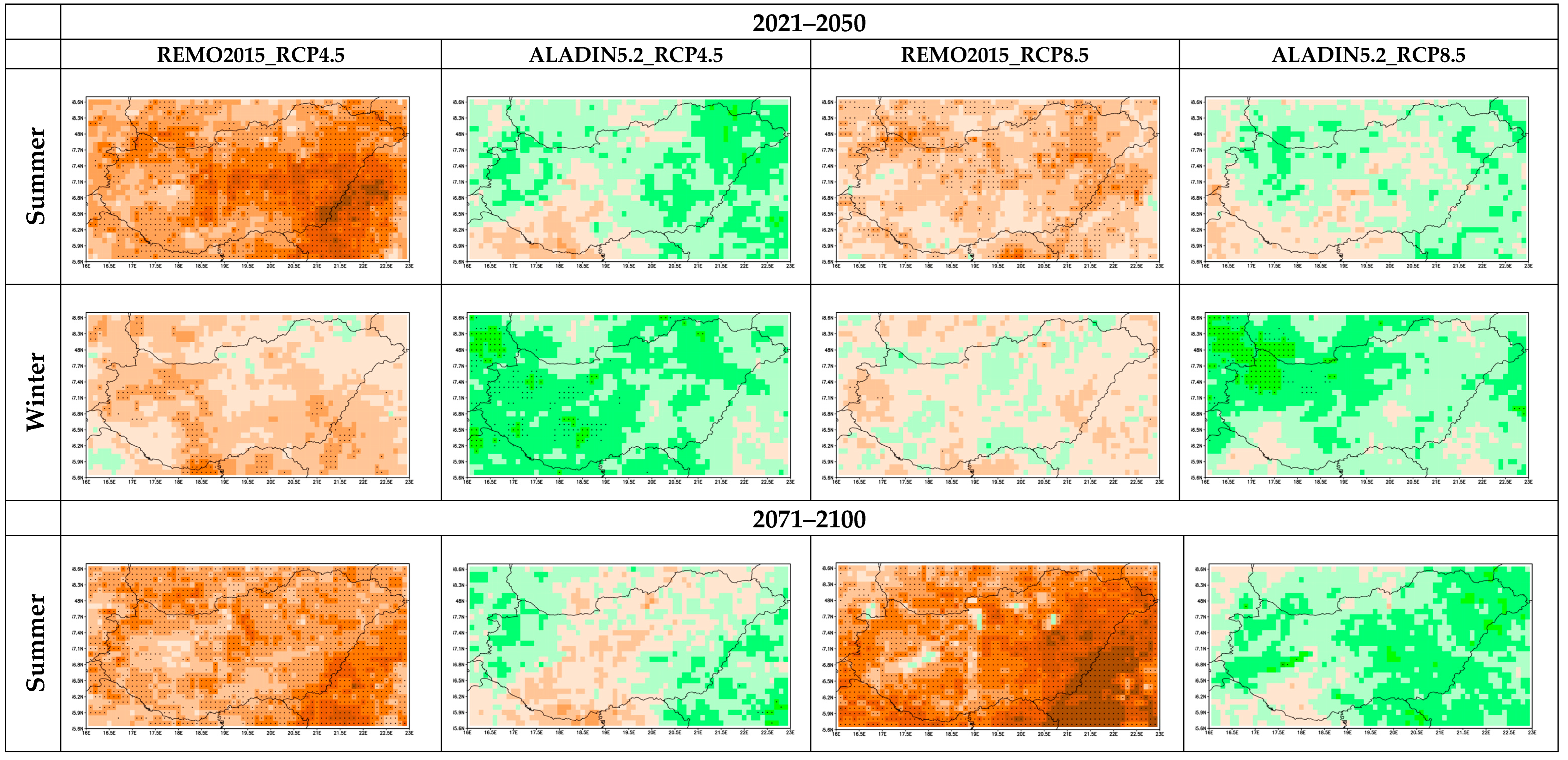

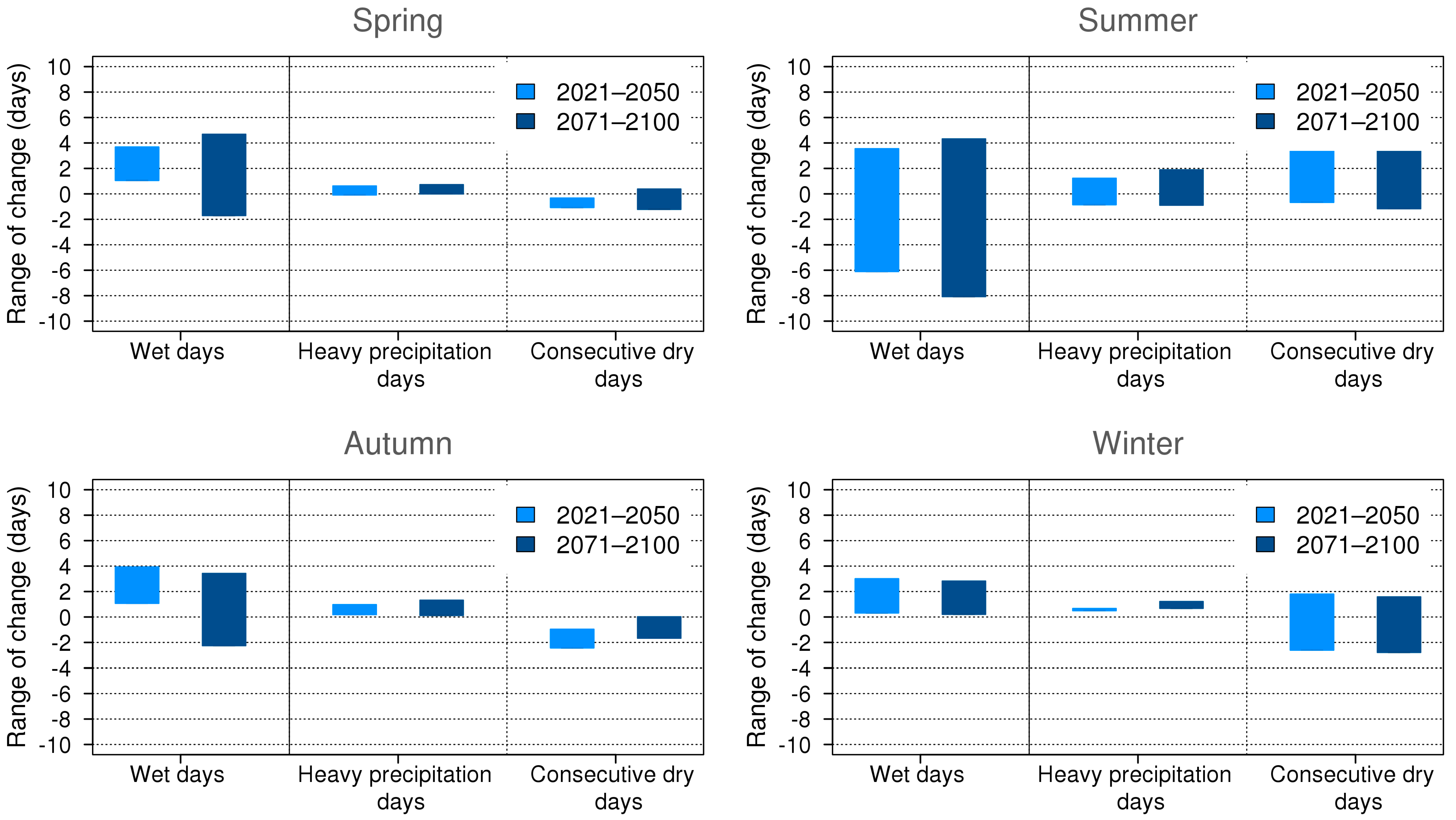
| ALADIN5.2 | REMO2015 | |
|---|---|---|
| Initial models | Dynamics: ALADIN NWP model | Dynamics: Europa Model |
| Parameterization: ARPEGE-Climat AGCM | Parameterization: ECHAM4 AGCM | |
| Dynamics | ||
| Handling of horizontal derivatives | Spectral method | Finite-difference method |
| Vertical coordinate system | Terrain-following pressure hybrid | |
| Description of vertical acceleration | Hydrostatic approach | |
| Prognostic variables | Horizontal wind speed components, surface air pressure, temperature, specific humidity | Horizontal wind speed components, surface air pressure, temperature, specific humidity, cloud water content |
| Temporal schemes | Combination of semi-implicit and semi-Lagrangian schemes | Leapfrog scheme with semi-implicit correction and an Asselin filter |
| Lateral boundary treatment | Davies [30] | |
| Physical parameterization | ||
| Radiation | Shortwave: Fouquart and Bonnel [31] Longwave: Mlawer et al. [32] | Shortwave: Fouquart and Bonnel [31] Longwave: Morcrette [33] |
| Land surface model | Tiling method according to SURFEX [34]: proportion of 3 surface types (nature, sea/ocean and lakes) within a grid cell. 3 soil layers | Tiling method: relative proportion of 3 surface types (land, water and ice) within a grid cell. 5 soil layers |
| Vertical diffusion and turbulent fluxes | Above natural surfaces: ISBA scheme [35] Above water surfaces: Charnock formula [36] | Monin and Obukhov [37] |
| Large-scale precipitation | Smith [38] | Sundqvist [39] |
| Microphysics | Ricard and Royer [40] | Lohmann and Roeckner [41] |
| Convection | Bougeault [42] | Tiedtke [43] |
| Model | ALADIN5.2 | ALADIN5.2 | REMO2015 | REMO2015 |
|---|---|---|---|---|
| Lateral boundary condition | ERA-Interim | CNRM-CM5 ALADIN5.2 | ERA-Interim | MPI-ESM-LR REMO2015 |
| Horizontal resolution | 0.12°~10 km | 0.09°~10 km | ||
| Map projection | Lambert conformal conic | Rotated spherical | ||
| Vertical levels | 31 | 27 | ||
| Timestep (seconds) | 360 | 360 | 60 | 60 |
| Evaluation simulations | ||||
| Integration period | 1980–2000 | 1950–2005 | 1980–2000 | 1950–2005 |
| Projection simulations | ||||
| Integration period | - | 2006–2100 | - | 2006–2100 |
| Scenarios | - | RCP4.5 RCP8.5 | - | RCP4.5 RCP8.5 |
| Climate Index | Definition | Validation | Projection |
|---|---|---|---|
| Summer days | Tmax > 25 °C | X | X |
| Hot days | Tmax ≥ 30 °C | X | X |
| Extremely hot days | Tmax ≥ 35 °C | X | |
| Tropical nights | Tmin > 20 °C | X | |
| Frost days | Tmin < 0 °C | X | X |
| Extremely cold days | Tmin < −10 °C | X | |
| Wet days | Rday ≥ 1 mm | X | X |
| Heavy precipitation days | Rday ≥ 10 mm | X | X |
| Consecutive dry days | The longest number of consecutive days when Rday < 1 mm | X | X |
| Model Simulation | MAM | JJA | SON | DJF | Annual |
|---|---|---|---|---|---|
| ALADIN5.2_ERAI | −1.5 | 0.9 | −1.1 | −0.7 | −0.6 |
| ALADIN5.2_CNRM | −2.0 | 2.5 | −1.1 | −1.9 | −0.6 |
| REMO2015_ERAI | 0.8 | 0.7 | 1.0 | 0.7 | 0.8 |
| REMO2015_MPI | 0.8 | 0 | 1.1 | 2.1 | 0.9 |
| Model Simulation | Tmin | Tmax |
|---|---|---|
| ALADIN5.2_ERAI | −0.3 | 0.5 |
| ALADIN5.2_CNRM | −0.5 | 1.1 |
| REMO2015_ERAI | 3.9 | −2.8 |
| REMO2015_MPI | 4.7 | −3.2 |
| Model Simulation | MAM | JJA | SON | DJF | Annual |
|---|---|---|---|---|---|
| ALADIN5.2_ERAI | 59 | 27 | 2.3 | 0.5 | 22 |
| ALADIN5.2_CNRM | 39 | 12 | 8.7 | 9.1 | 9.0 |
| REMO2015_ERAI | 18 | 3.3 | −3.4 | 3 | 4.9 |
| REMO2015_MPI | 19 | −0.3 | −14 | 22 | 5.1 |
Disclaimer/Publisher’s Note: The statements, opinions and data contained in all publications are solely those of the individual author(s) and contributor(s) and not of MDPI and/or the editor(s). MDPI and/or the editor(s) disclaim responsibility for any injury to people or property resulting from any ideas, methods, instructions or products referred to in the content. |
© 2023 by the authors. Licensee MDPI, Basel, Switzerland. This article is an open access article distributed under the terms and conditions of the Creative Commons Attribution (CC BY) license (https://creativecommons.org/licenses/by/4.0/).
Share and Cite
Megyeri-Korotaj, O.A.; Bán, B.; Suga, R.; Allaga-Zsebeházi, G.; Szépszó, G. Assessment of Climate Indices over the Carpathian Basin Based on ALADIN5.2 and REMO2015 Regional Climate Model Simulations. Atmosphere 2023, 14, 448. https://doi.org/10.3390/atmos14030448
Megyeri-Korotaj OA, Bán B, Suga R, Allaga-Zsebeházi G, Szépszó G. Assessment of Climate Indices over the Carpathian Basin Based on ALADIN5.2 and REMO2015 Regional Climate Model Simulations. Atmosphere. 2023; 14(3):448. https://doi.org/10.3390/atmos14030448
Chicago/Turabian StyleMegyeri-Korotaj, Otília A., Beatrix Bán, Réka Suga, Gabriella Allaga-Zsebeházi, and Gabriella Szépszó. 2023. "Assessment of Climate Indices over the Carpathian Basin Based on ALADIN5.2 and REMO2015 Regional Climate Model Simulations" Atmosphere 14, no. 3: 448. https://doi.org/10.3390/atmos14030448
APA StyleMegyeri-Korotaj, O. A., Bán, B., Suga, R., Allaga-Zsebeházi, G., & Szépszó, G. (2023). Assessment of Climate Indices over the Carpathian Basin Based on ALADIN5.2 and REMO2015 Regional Climate Model Simulations. Atmosphere, 14(3), 448. https://doi.org/10.3390/atmos14030448





